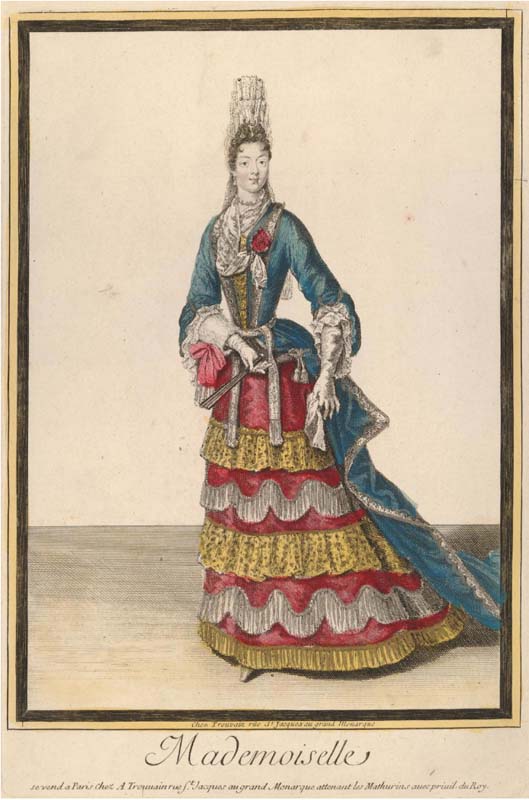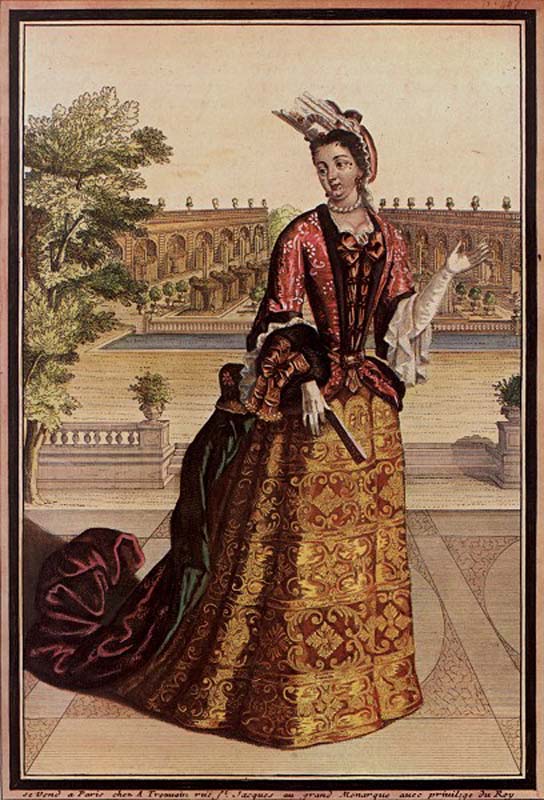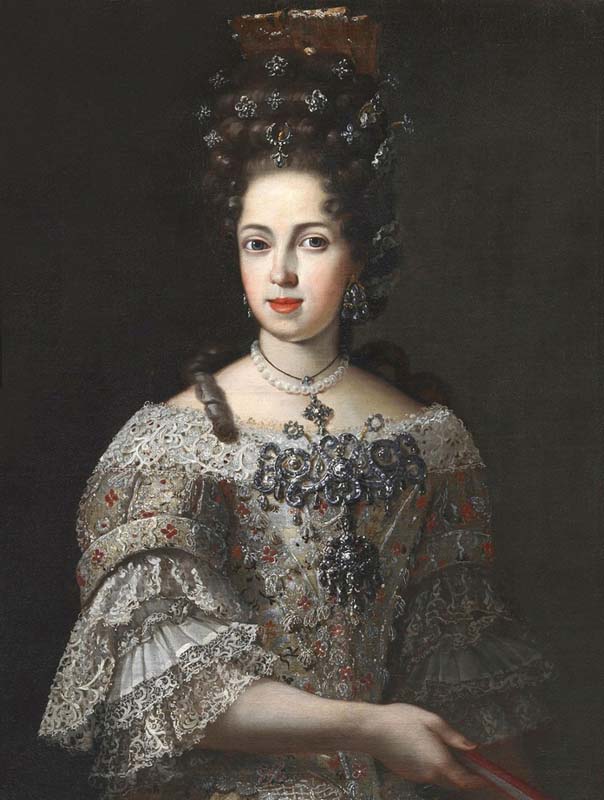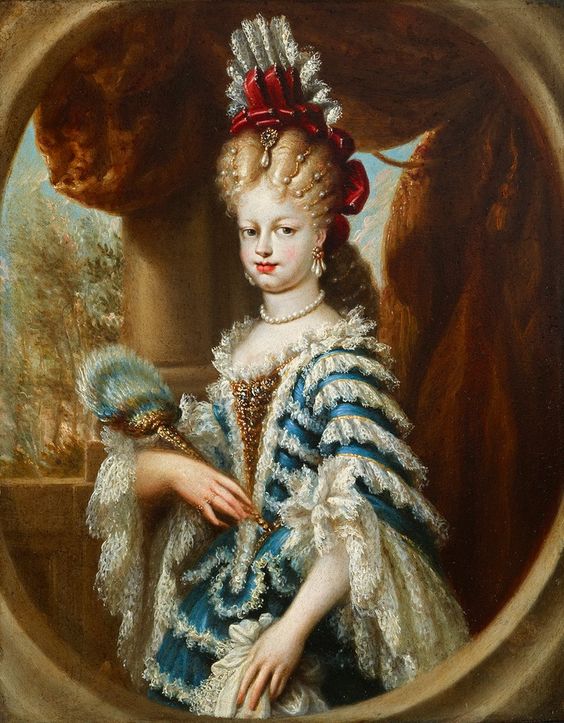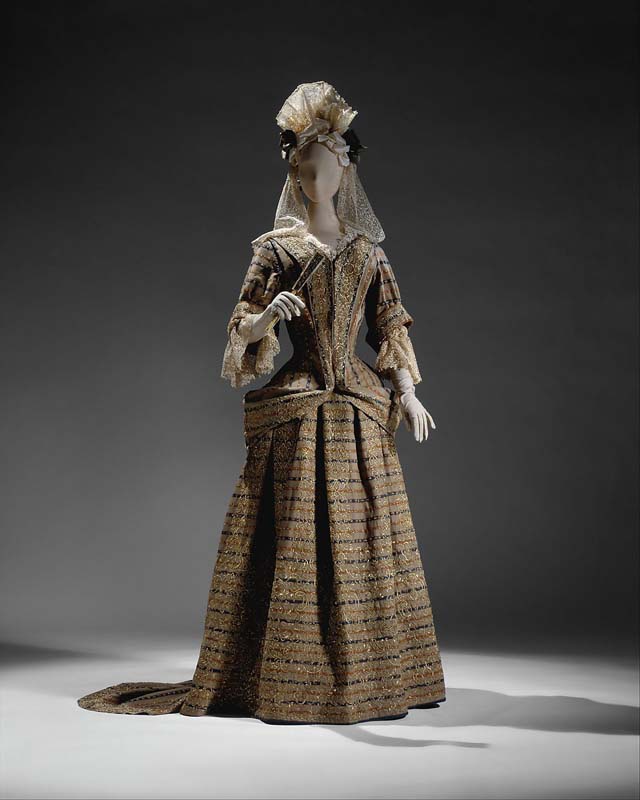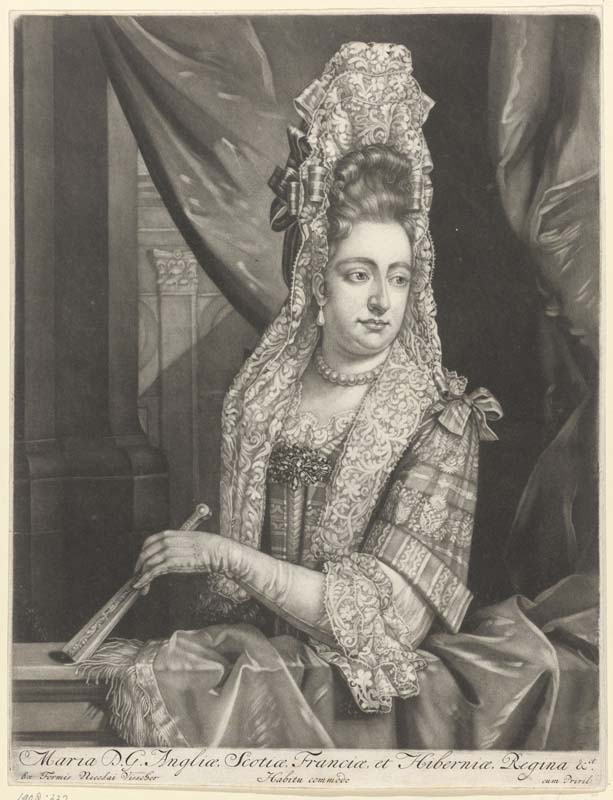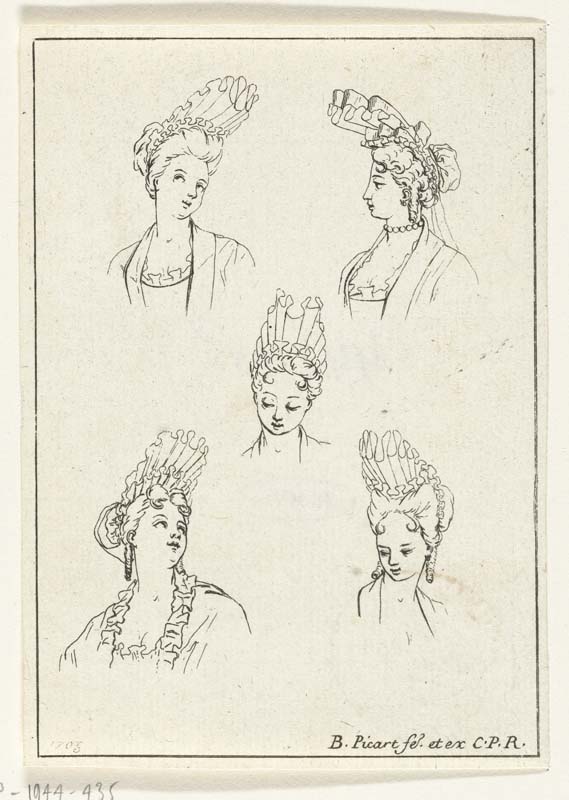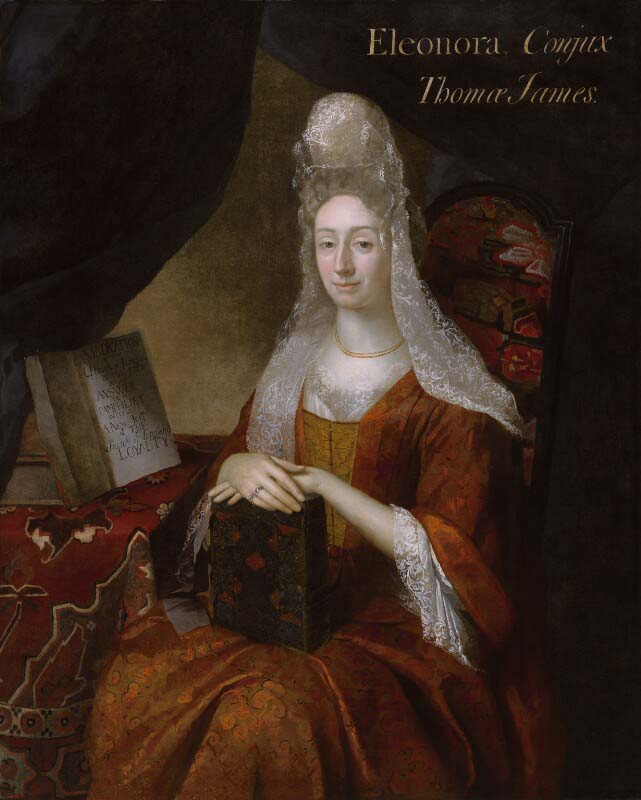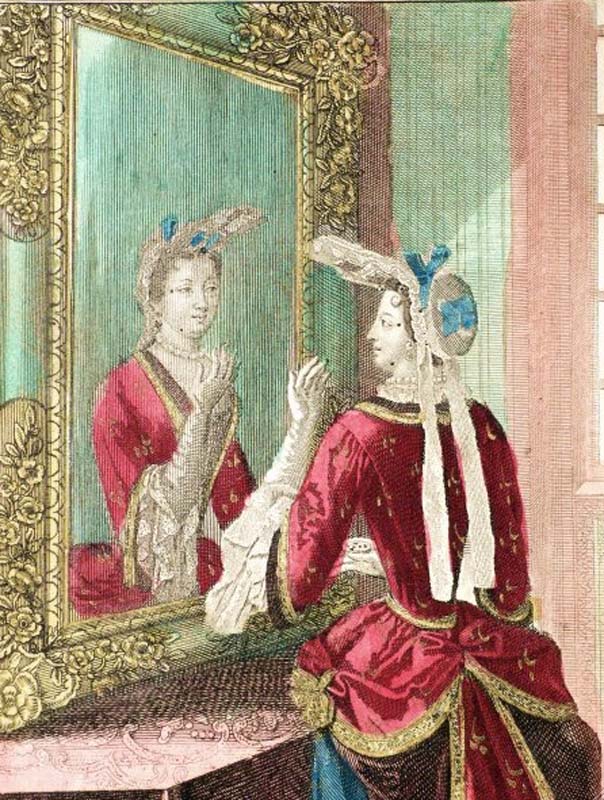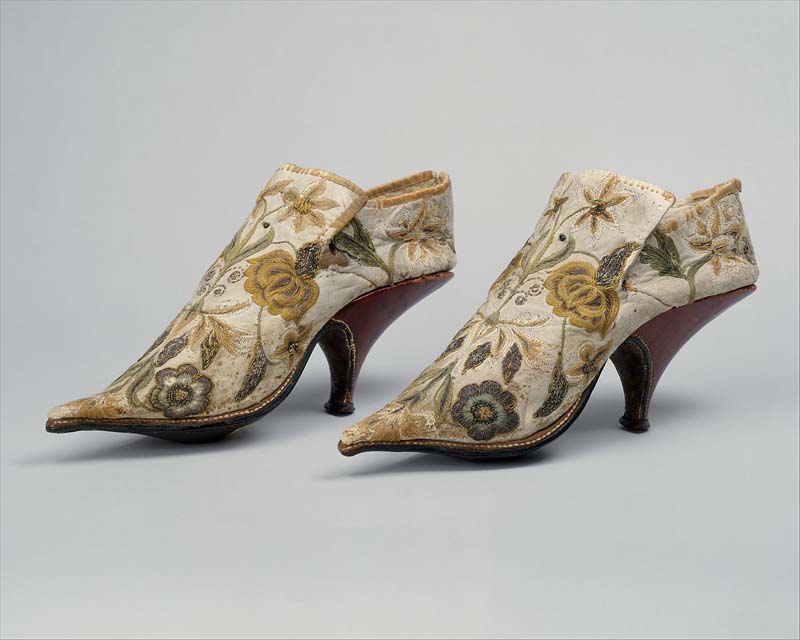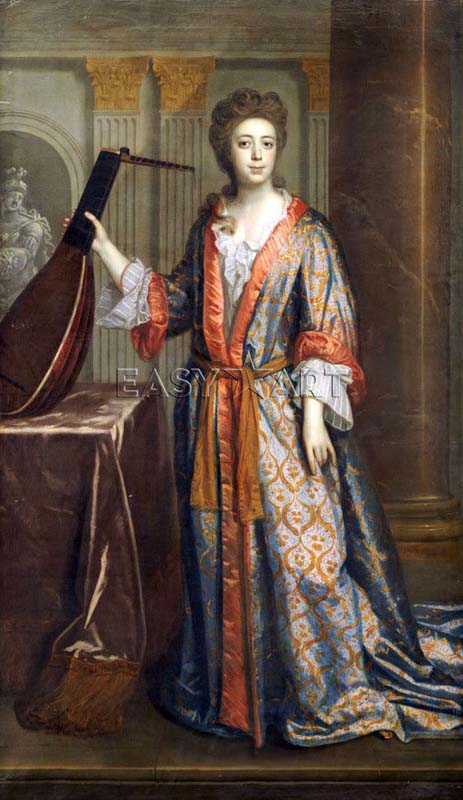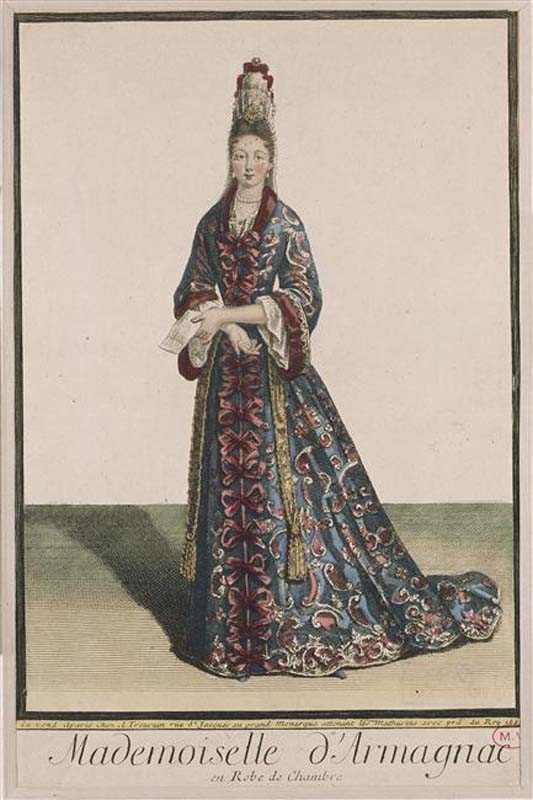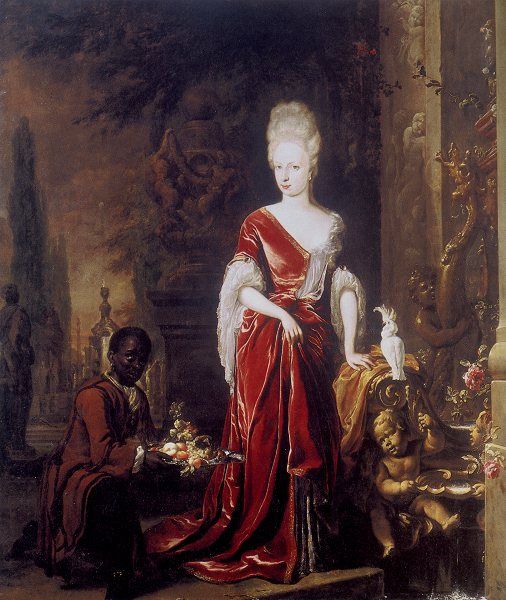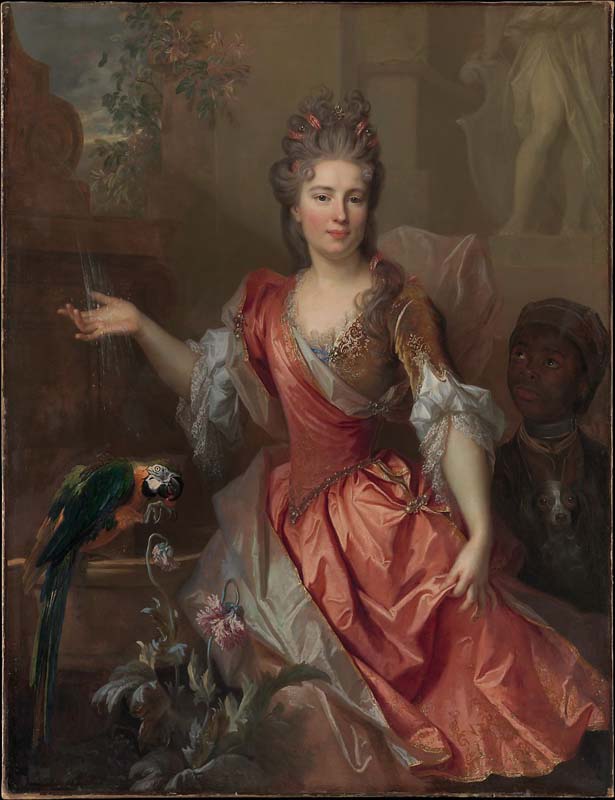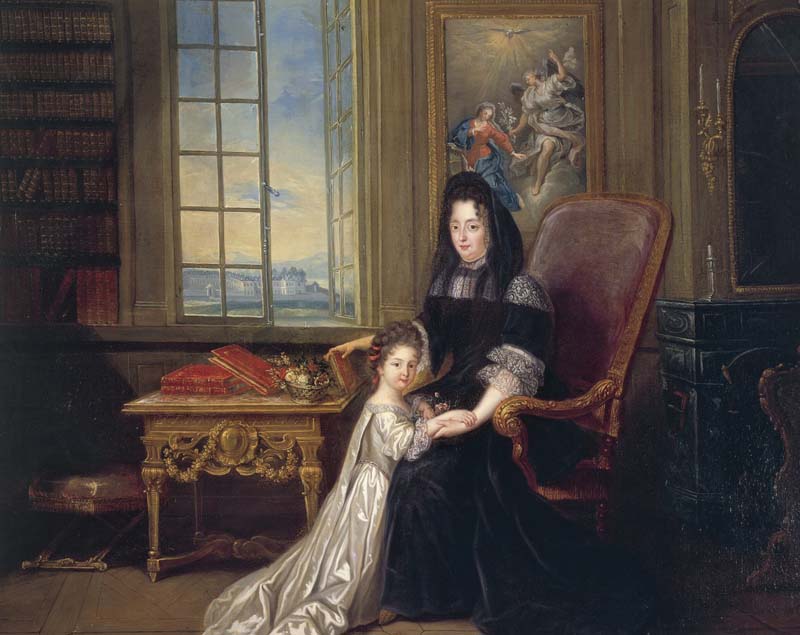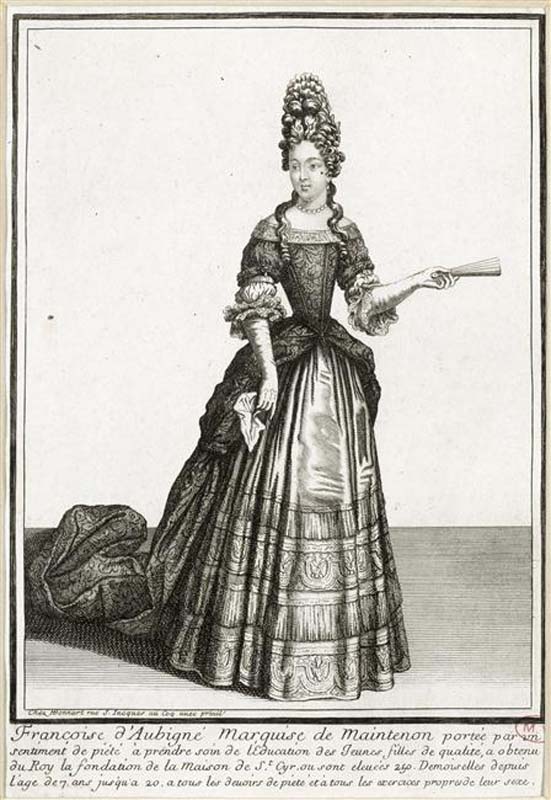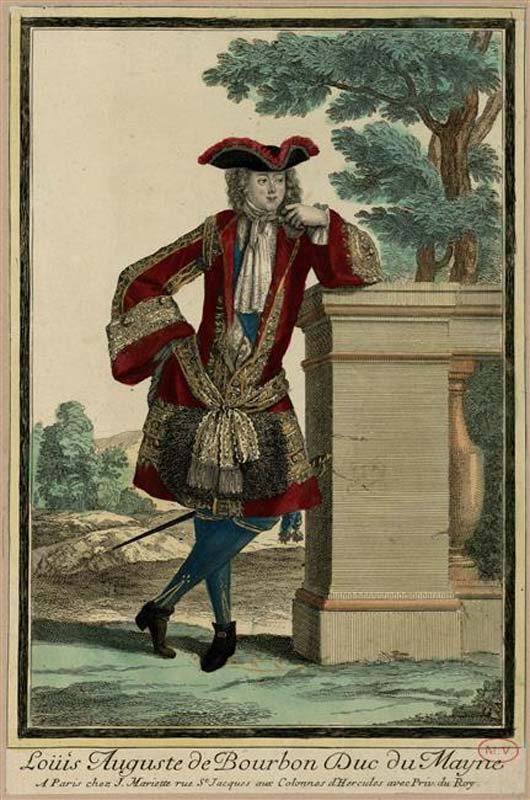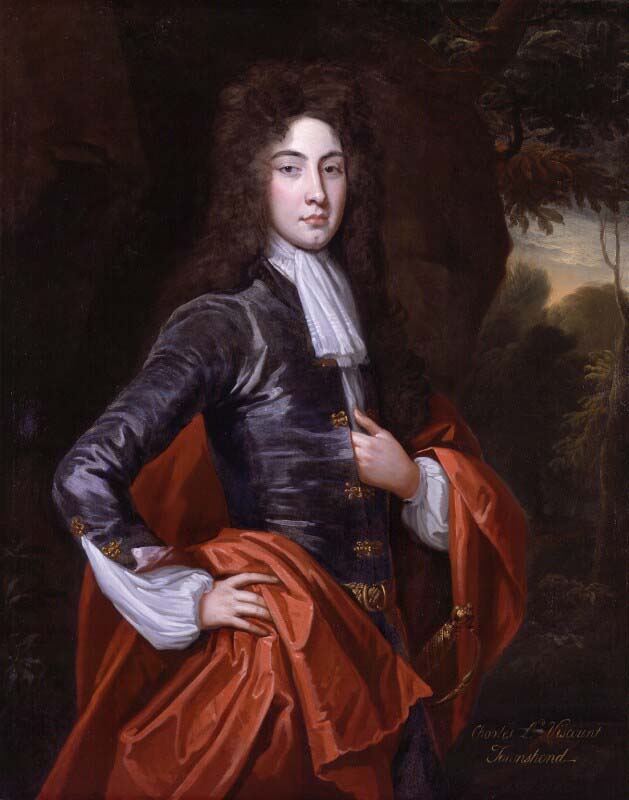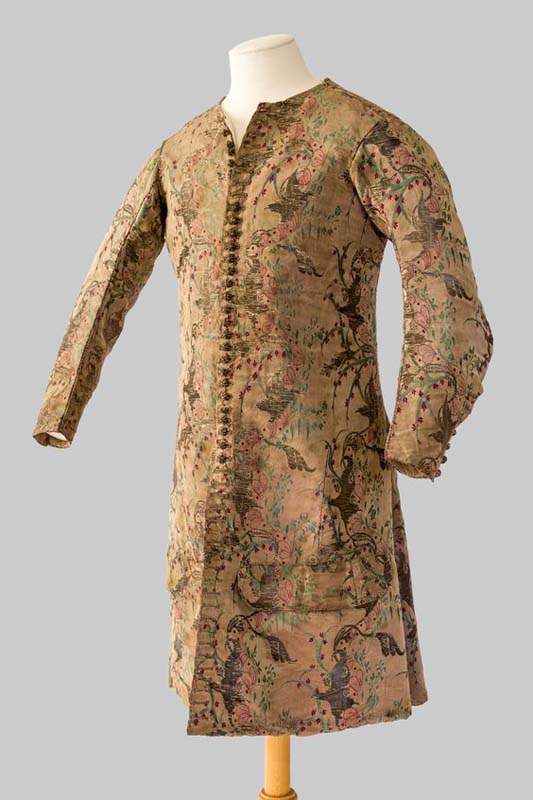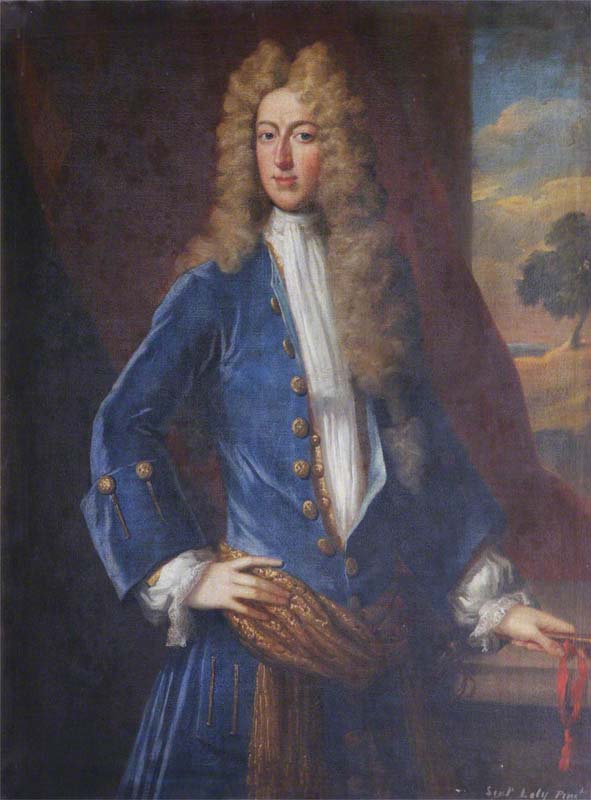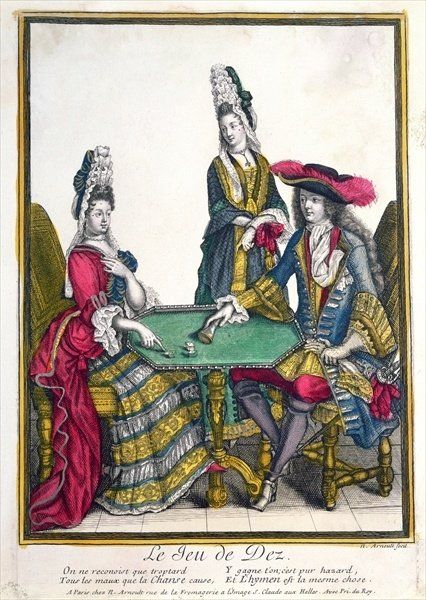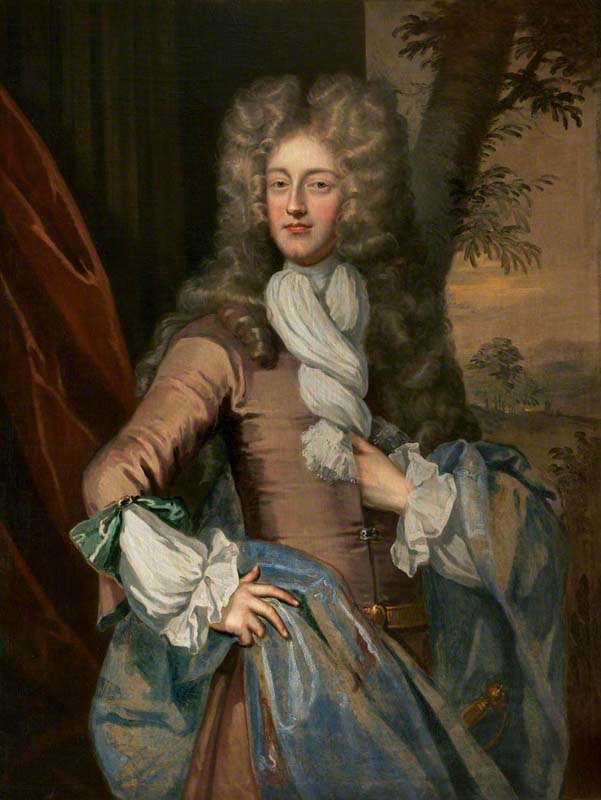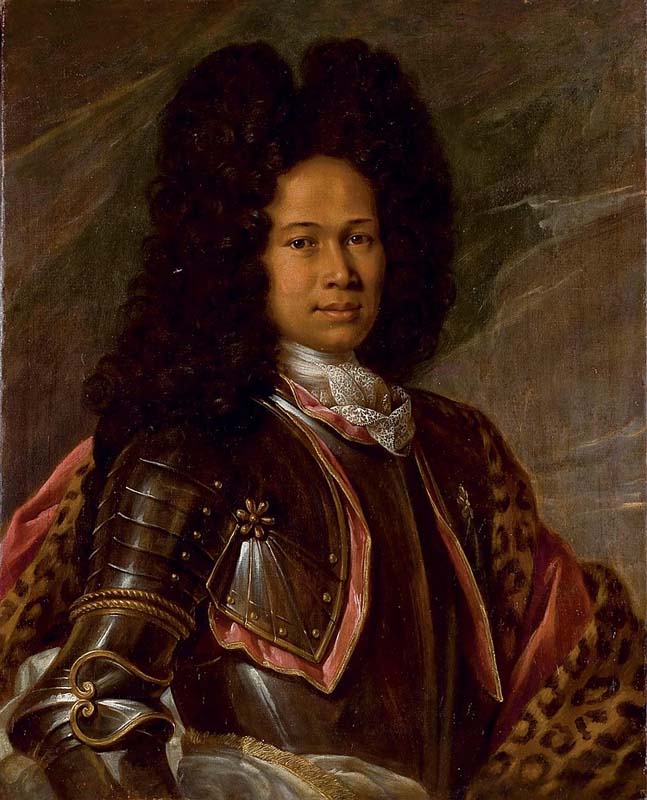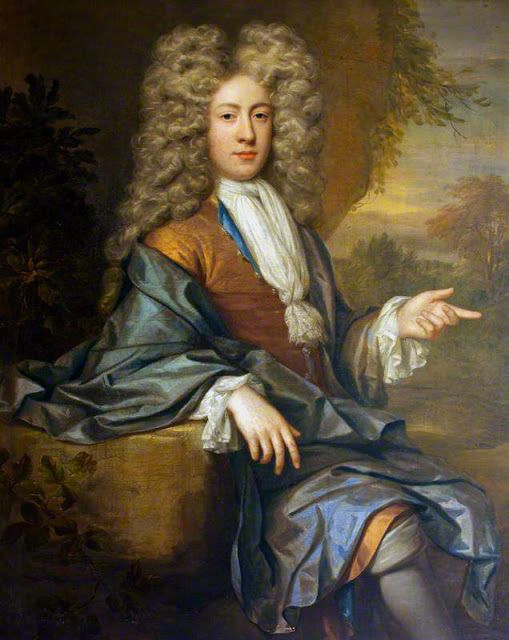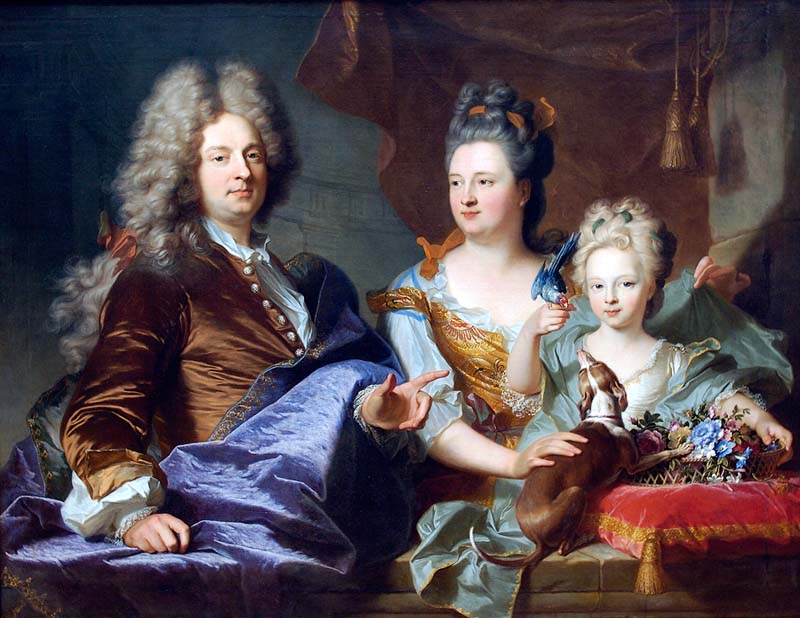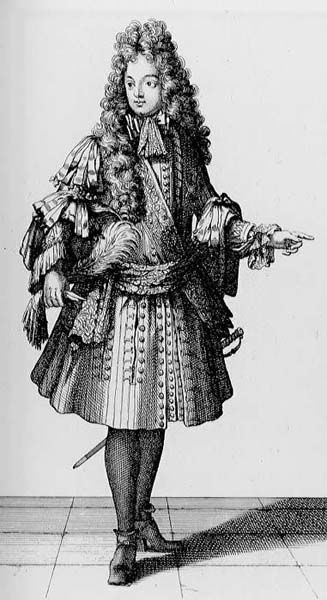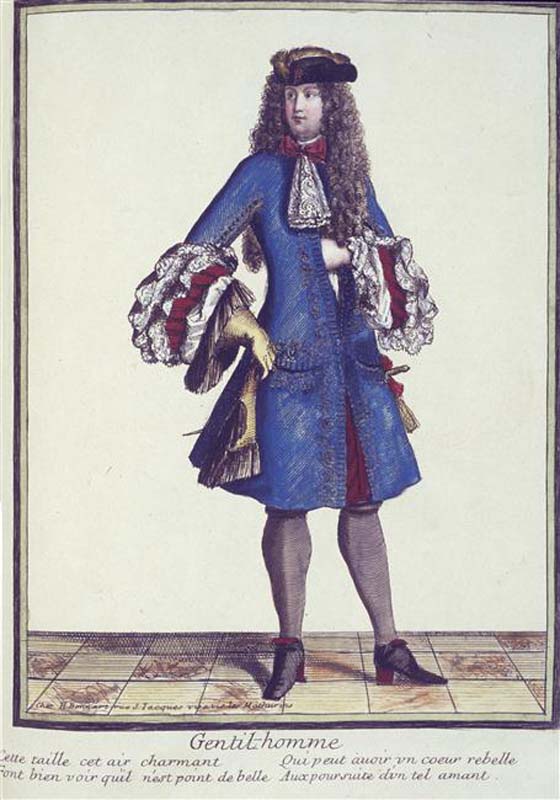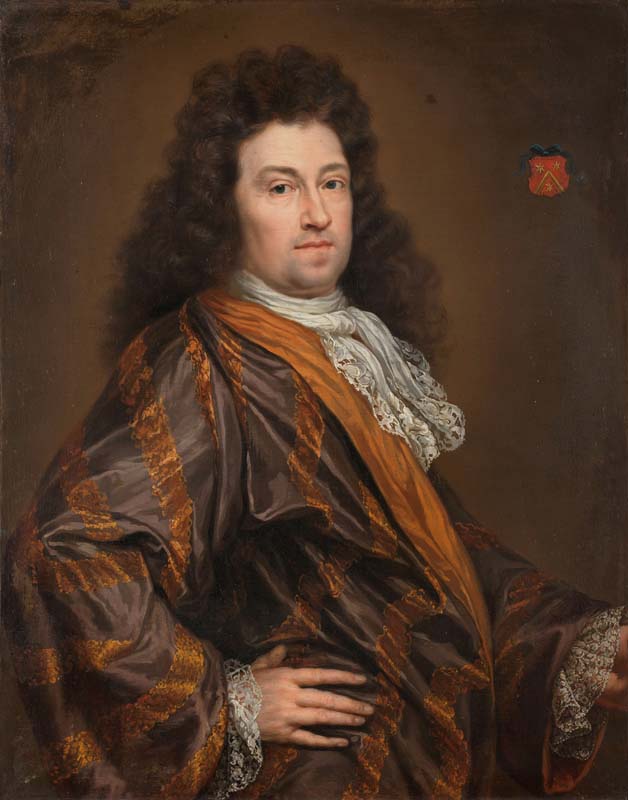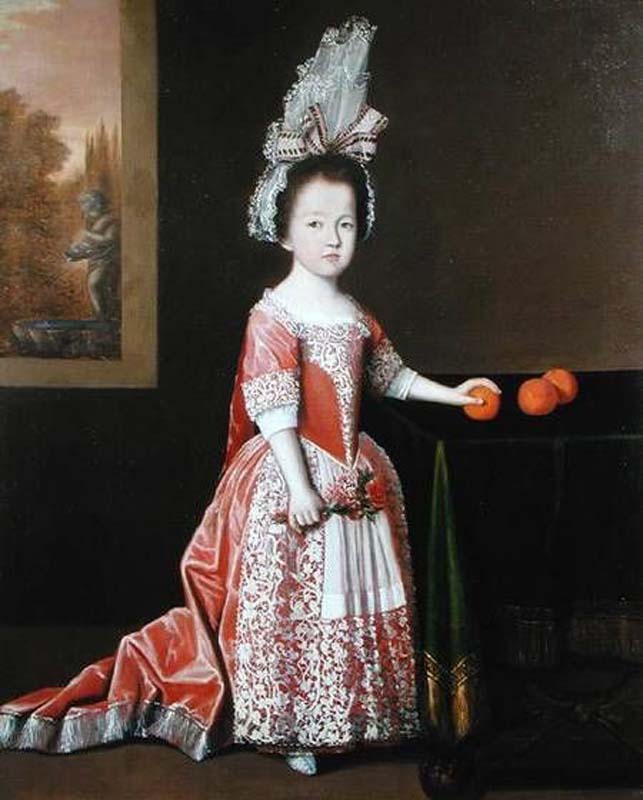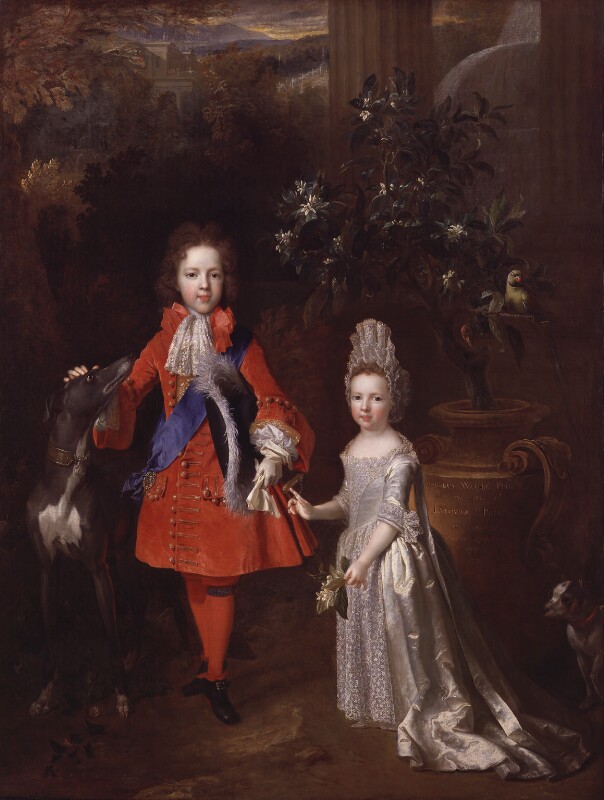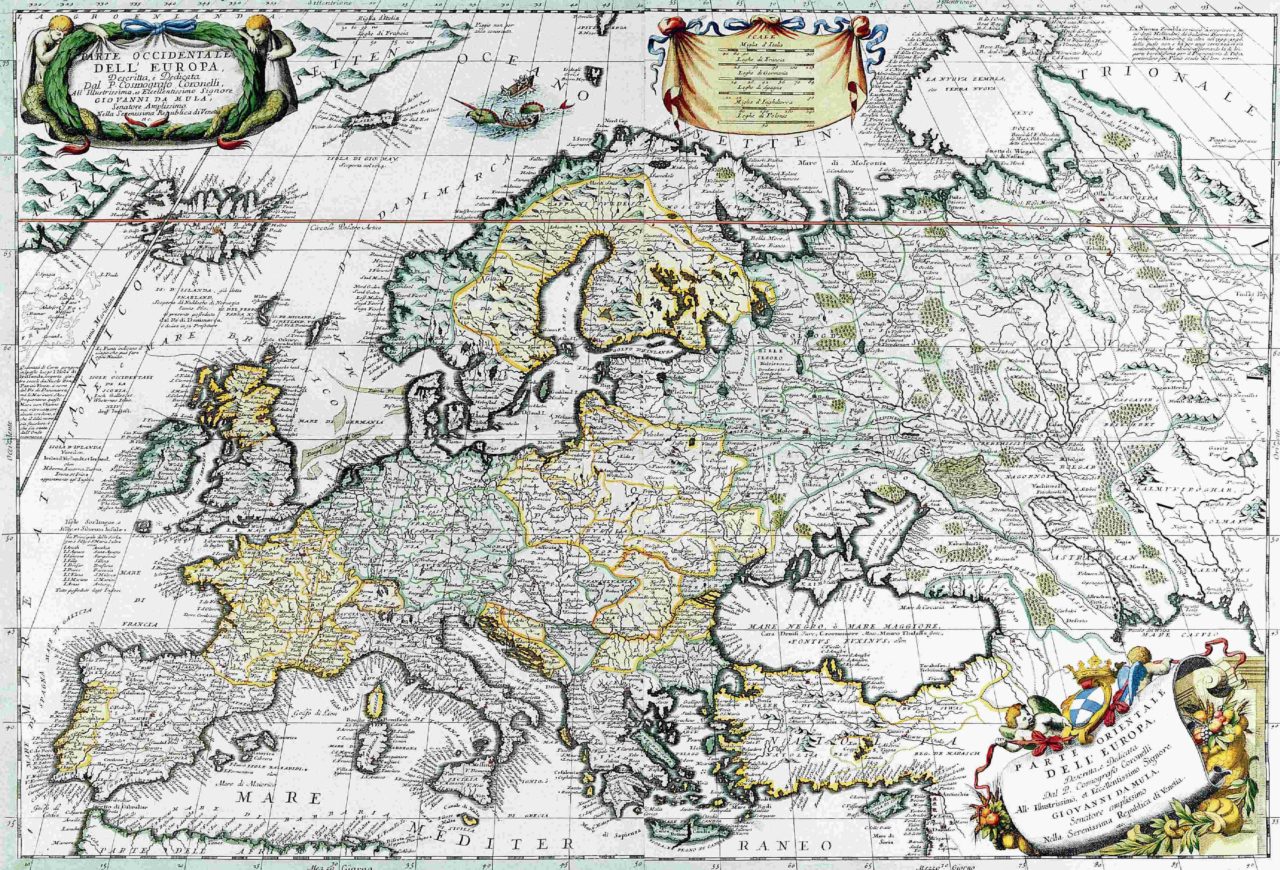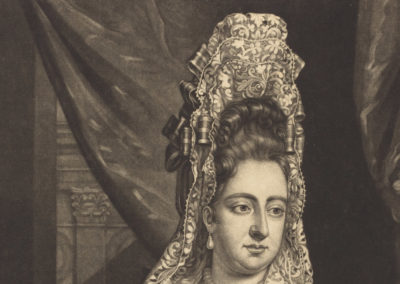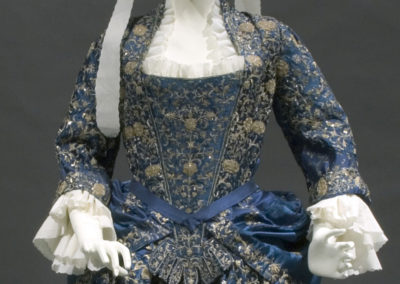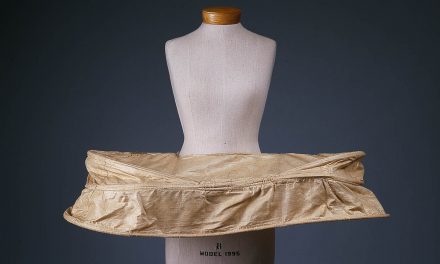OVERVIEW
The 1690s silhouette for women was extremely vertical and linear with the long-trained mantua being amplified by the towering fontange lace headdress. The more modest jacket-style mantua bodices are often attributed to the influence of Madame de Maintenon, the secret wife of King Louis XIV. Men’s coats gained fuller skirts and their wigs were now two-peaked and, by the end of the century, powdered gray or white.
Womenswear
In the 1690s, women’s dress achieved an even more vertical effect (Fig. 1), as the narrowness of the mantua and the height of the fontange headdress increased. A fashion print depicting the daughter of the Duke d’Orléans (Fig. 1) gives a good idea of the overall silhouette; notably she wears a variation of the steinkirk cravat, a menswear influence [see Menswear below].
The foundation of women’s dress remained the chemise (also known as a smock or shift), upon which now boned stays (early corsetry) were now typically worn. The mantua was the dominant form of dress and:
“By the end of the century the mantua and petticoat were made from matching fabric, with contrasting material used for the lining of the mantua. Petticoats were decorated with horizontal bands of lace or fringing (furbelows).” (Brown 139)
Charlotte-Félicité (Fig. 2), the Duchess of Modena, wears a mantua and petticoat made of matching striped silk brocade fabric. The intense horizontal fringe and lace decoration mentioned by Brown feature in figure 1. Mantuas and petticoats were still sometimes made of contrasting fabrics as well; see, for example, a portrait of the Comtesse de Mailly in 1698 (Fig. 3). In either case, mantuas featured long trains (Figs. 1, 3).
Fig. 1 - Antoine Trouvain (French, 1652-1708). Portrait of the daughter of the Duke of Orléans (Marie Louise d'Orléans?), ca. 1680-1700. Hand-coloured engraving; 30.5 x 20.2 cm. London: The British Museum, 1917,1208.3777. Source: British Museum
Fig. 2 - Artist unknown (French). Charlotte-Félicité of Hanover and Brunswick, duchess of Modena, 1696-1710. Etching and watercolor; 30.7 x 19.8 cm. Versailles: Palace of Versailles, INV.GRAV 2010. Source: Versailles
Fig. 3 - Artist unknown. La Comtesse de Mailly, 1698. Source: Wikipedia
Fig. 4 - Artist unknown (Italian). Princess Ana Maria Luisa of the Palatinate, ca. 1690s. Source: Grand Ladies
Fig. 5 - Miguel Jacinto Melendez (Spanish, 1679-1734). Portrait of Queen María Luisa Gabriela of Savoy, ca. 1701-3. Oil on copper; 27.2 x 21.2 cm (10 3/4 x 8 3/8 in). Dallas: Meadows Museum, MM.2013.04.02. Museum purchase with funds generously provided by Richard and Gwen Irwin and The McDermott Foundation. Source: Meadows Museum
Jane Ashelford describes the decorative aesthetic of the period in The Art of Dress: Clothes and Society:
“A love of busy surface decoration, whether it be in the form of scarves, ruched ribbons, braids or bands of metal fringe, was typical of male and female fashion in the 1680s and 1690s.” (101)
Princess Ana Maria Luisa of the Palatinate (Fig. 4) wears a luxurious silk brocade bodice that is further ornamented with silver lace and a massive jeweled bodice ornament. Queen Maria Luisa Gabriela of Savoy (Fig. 5) wears a blue silk bodice and petticoat trimmed in tiers of ruffled lace. [We’ll see this is less true of 1690s menswear, as discussed below].
Sleeves ended at the elbow and large cascades of lace (sometimes attached to the chemise, but later often independent) then billowed forth, these are called engageantes in French (Fig. 5).
The mantua now covered the shoulders, often having the appearance of the jacket (Figs. 1, 3). It closed down the front, usually with a stomacher (Figs. 1-3). The stomacher was often decorated as previously with a ladder of bows down the front (Figs. 2-3), but metallic laces (Figs. 1, 5) were also popular, as were jeweled bodice ornaments (Fig. 6).
Fig. 6 - Italian School (attributed) (Italian). Portrait of a lady, half length, in a mantua gown and lace frelange headdress, ca. 1690. Oil on canvas; 119.3 x 98 cm (47 x 38 5/8 in). Private Collcetion. Source: Sothebys
Fig. 7 - Designer unknown (British). Mantua, late 17th century. Wool, metal thread. New York: Metropolitan Museum of Art, 33.54a-c. Rogers Fund, 1933. Source: MET
Fig. 8 - Nicolaes Visscher I (Dutch, 1618-1709). Portrait of Maria II Stuart, 1688-1709. Paper, mezzotint. Amsterdam: Rijksmuseum, RP-P-1908-332. Source: Rijksmuseum
Sometimes, as in an example in the Metropolitan Museum’s collection (Fig. 7) the mantua was simply pinned closed at center front. Fabrics were typically darker than in previous decades and patterned, with silk brocades being the most desirable textile (Figs. 2-4, 7). At Versailles, women were required to wear French silk year-round, prompting complaints:
“In 1695, a lady of the French court complained that women were turning blue from the cold when required to wear silk dresses in winter.” (Met Museum)
But elsewhere, particularly in England, as Ashelford notes: “in the 1690s there was a falling-off of [the domestic silk] trade as the influx of imported cottons reduced the demand for silks and the East India Company imported silks that sold at a cheaper price than home made ones.” (110)
This led to protests which forced the British government to act:
“In 1697 5,000 weavers mobbed the House of Commons and in 1701 an act was passed that forbade the use or wearing of imported silks and ‘calicoes painted, dyed, printed or stained’ in China, the East Indies and the Middle East.” (Ashelford 110)
While weavers were facing increasing competition, the whole system of who made clothing was also in the midst of a sea change begun in previous decades, with male tailors being displaced by female dressmakers. Ashelford offers more details:
“By the end of the century the tailor’s position as the only person who made male and female clothes had been challenged by the seamstresses. Consigned until then to sewing linen underwear and accessories, the seamstresses started making the unboned mantua and, when stiff-bodied gowns ceased to be fashionable, took over the making of all gowns. Known as mantua-makers, they opened up their own establishments leaving the tailors to make only women’s riding habits while male stay-makers made the stays or corsets, as these were now separate from the bodice.” (115, 117)
The fontange lace headdress was now omnipresent (Figs. 1-3, 5-12); what began as a small cap pinned to the back of the head now had a tall wire frame attached with tiers of lace, ribbons and ruffles (Fig. 8) ((Hill 413). The lace tower could be quite vertical, but also sometimes tilted forward at quite a severe angle (Fig. 9). Fontanges appear constantly in fashion prints of the day, but women sometimes chose not wear them in portraits, perhaps sensing that the trend would not last. A few women, however, were painted wearing fontanges (Figs. 5-6), such as Donna Ippolita Montalto (Fig. 10) and Eleanor James (Fig. 11); James’s
“spectacular head-dress consists of a wire frame formed into a high domed shape over which lace has been placed. It is gathered into ruffles at the sides of her face, then falls over the shoulders as two lappets. The cost of such delicate lace must have been considerable.” (Ashelford 101)
Fig. 9 - Bernard Picart (French, 1673-1733). Five female heads in different positions, with fontange, 1703. Etching on paper; 10.8 x 7.8 cm. amsterdam: rijksmuseum. Source: rijksmuseum
Fig. 10 - Paolo de Matteis (Italian, 1662-1728). Donna Ippolita Montalto, 1690s. Oil on canvas; 103 x 76 cm. Source: Pinterest
Fig. 11 - Artist unknown (British). Eleanor James, ca. 1690. Oil on canvas; 126.8 x 103.5 cm (49 7/8 x 40 3/4 in). London: National Portrait Gallery, NPG 5592. Source: NPG
Fig. 12 - Antoine Trouvain (French, 1652-1708). Diane Gabrielle Damas de Thianges, duchesse de Nevers, 1696. Source: Grand Ladies
Fig. 13 - Designer unknown (French). Shoes, 1690-1700. Silk, leather. New York: Metropolitan Museum of Art, 06.1344a, b. Rogers Fund, 1906. Source: MET
Fig. 14 - Thomas Murray (Scottish, 1663-1734). Portrait of Henriette D’Auverquerque, 1690s. Source: Pinterest
Fig. 15 - Antoine Trouvain (French, 1652-1708). Mademoiselle d'Armagnac (Charlotte de Lorraine) en robe de chambre, 1695. Watercolor engraving; 31 x 21.3 cm. Versailles: Palace of Versailles, INV.GRAV 1978. Source: Versailles
Fig. 16 - Jan Weenix (Dutch, 1640-1719). Elisabeth Charlotte of the Palatinate, wife of Philippe d'Orléans, 1691. Oil on canvas; 133 x 117 cm. Berlin: State Museums of Berlin, 919A, 1872. Source: BildIndex
Fig. 17 - Nicolas de Largillierre (French, 1656-1746). Woman and an Enslaved Servant, 1696. Oil on cavnas; 139.7 x 106.7 cm (55 x 42 in). New York: Metropolitan Museum of Art, 03.37.2. Rogers Fund, 1903. Source: MET
In terms of accessories, stoles, that is “a narrow scarf-like wrap of cloth or fur worn around the shoulders and draped over the arms” (Hill 412), were becoming popular. Pearls remained popular (Figs. 1-6, 8, 12), but the period also saw a surge in popularity in large jeweled bodice ornaments as discussed above (Figs. 4, 6, 8). Black patches, essentially fabric beauty marks, continued to be worn (Fig. 3) (see the 1680s overview for more examples); a 1696 print of the Duchess de Nevers (Fig. 12) even shows her applying black patches in the mirror. The print is useful also for the back view of the mantua it provides and for allowing us to see the streaming lappets from her fontange.
Women would wear stockings held up by garters, though no underwear. As skirts were floor-length shoes were rarely seen, but they continued to be high-heeled and come to a narrow point (Fig. 13). Informal garments like the nightgown were worn in the home; unlike nightgowns today, they were not worn to sleep in but as a form of comfortable dress (Fig. 14). Anna Reynolds explains further in In Fine Style: The Art of Tudor and Stuart Fashion (2013):
“A seventeenth-century nightgown can be seen in the portrait of Henriette D’Auverquerque, Countess of Grantham. She wears her belted silk nightgown over her smock, apparently without stays. During the seventeenth century the nightgown was gradually worn for more formal occasions, and it is believed to be the origin of the mantua.” (54)
Mademoiselle d’Armagnac (Fig. 15) wears a robe de chambre, a French version of the nightgown and precursor of the mantua; the closed gown features a ladder of ribbons all the way down the center front.
Racist portraiture tropes remained all too common, as in previous decades. White women like Elisabeth Charlotte of the Palatinate (Fig. 16) would pose alongside Black servants or slaves to emphasize the paleness of their own skin and also boast of their own wealth in having such “exotic” people in their employ. The portraits blend the classical and the colonial, featuring garden settings with classical statuary alongside exotic birds like parrots. Nicholas de Largillierre’s Woman and Enslaved Servant is another example of the trope (Fig. 17). In both examples, the women wear a blend of classical drapery and contemporary styles and do not include the fontange headdress. The Met in discussing its portrait (Fig. 17) emphasizes how our understanding of these paintings and the Black individuals in them has shifted:
“Long naturalized as artistic conventions, documentary evidence actually points to the reality of such enslaved individuals who served as personal servants to the aristocrat or prominent individual who was the principal sitter…. Juxtaposed with the dog, this kind of image not only made the racist association of African descended people with animals but, moreover, slaveowners’ fantasy of their natural fidelity to Europeans within a hierarchy of races. The dehumanizing attitude towards Africans rose alongside the slave trade, which spiked in the seventeenth century.”
It should not be forgotten that many of the lavish fashions worn at the time were made possible by the exploitation of enslaved people in the European colonies and these portraits are an important reminder of that reality, however “fantastical” they may have been considered at the time.
Fashion Icon: Françoise d’Aubigné, Marquise de Maintenon
Fig. 1 - Louis Elle le Père (attributed) (French, 1612-89). Portrait of Francoise d'Aubigne (1635-1719), Marquise de Maintenon, with her niece Francoise d'Aubigne (1684-1739), the future Duchess of Noialles,, 1688. Oil on canvas; 224 x 154.6 cm. Versailles: Palace of Versailles, MV 2196. Source: Versailles
Widowed at 25, Françoise in the 1660s became the governess for Louis XIV’s then-illegitimate children born to his mistress Madame de Montespan. Louis XIV formally recognized the children in 1673 and Françoise became the official royal governess. She gained her title and a vast estate the following year:
“In 1674, the king rewarded Scarron with 200,000 livres, enabling her to purchase the Chateau de Maintenon, a medieval castle near Versailles, which was extensively rebuilt to function as her private residence. She was given her title, the Marquise of Maintenon, the following year; these favours, along with the king’s frequent visits to Maintenon, excited the suspicion and jealousy of Madame de Montespan, who eventually left court in 1680.” (Apollo)
Fig. 2 - Pierre Mignard (French, 1612-95). Françoise d’Aubigné, marquise de Maintenon, en sainte Françoise Romaine, ca. 1694. Oil on canvas; 129.7 x 97.5 cm. Versailles: Palace of Versailles, MV 3637. Source: Versailles
Fig. 3 - Pierre Gobert (French, 1662-1744). Portrait of Madame de Maintenon depicted with her black servant, ca. 1695. Oil on canvas; 87.6 x 67.3 cm (34 1/2 x 26 1/2 in). Private Collection. Source: Timothy Langston
Fig. 4 - Claude-François Vignon (attributed) (French, 1633-1703). Portrait of Madame de Maintenon, last third of the 17th century. Oil on canvas; 116 x 97 cm. Source: La Gazette Drouot
Fig. 5 - Artist unknown (French). Françoise d'Aubigné, marquise de Maintenon (1635-1719) in court dress, a fan in her hand, late 17th century. Versailles: Palace of Versailles, invGravures2194. Source: RMN
She secretly married Louis XIV after the death of Queen Marie-Thérèse in 1683; Maintenon was never officially recognized as Queen or the King’s wife due to the disparity in their social status. A devout Catholic, Maintenon is credited (or blamed) for the more conservative turn in both men’s and women’s fashions of the 1680s and 1690s (read more about this in the 1680s overview); for example:
“Under the insistently moral influence of Mme de Maintenon, shoulders become covered again, in the 80s, and the neckline approximately square.” (Davenport 519)
A portrait of Maintenon with her niece shows this more severe style with Maintenon dressed all in black (Fig. 1). She also commissioned a portrait of herself dressed as the 15th-century French saint Françoise Romaine (Fig. 2), an unusual choice. However, she did also appear in a portrait with a Black servant, an all too common trend of the time discussed above, in a portrait by Pierre Gobert (Fig. 3), which features enveloping classical-style drapery and omits the fontange headdress typically worn in daily life. Though never formally recognized as France’s queen, she did wear royal blue robes lined with ermine in another portrait (Fig. 4) where she pairs a boned court bodice with a prominent crucifix and lace headdress with deep black lappets which provide some modesty for the off-the-shoulder neckline.
Disappointed in her own convent education, she established the Maison royale de Saint-Louis, a school for girls from impoverished noble families, in 1684 (Wikipedia). A fashion print of the time (Fig. 5), featuring Maintenon in a mantua and fontange, details her positive educational efforts in the caption, crediting her with educating more than 250 girls. In addition to influencing fashion and women’s education, she played a powerful role at the French court affecting everything from domestic to foreign policy (Wikipedia).
Menswear
In the 1690s the fundamentals of men’s dress remained the same: shirt, waistcoat/vest, coat (justaucorps) and breeches. This male uniform would be maintained into the 19th century, though with many changes to cut and style. In this decade, the cut of the justaucorps would shift to set off the waist even more by increasing the fullness of the skirts by goring and pleating. A fashion print depicting Louis-Auguste de Bourbon, Duc du Mayne (Fig. 1) gives a good idea of the overall silhouette. The Cunningtons describe the look in their Handbook of English Costume in the Seventeenth Century (1972):
“A good fit and defined waist, the effect being increased by a fuller skirt which flared out fan-wise from pleats closely stitched down at the apex of each side vent where a decorative button was placed.” (139)
Sleeves became much fuller as well, with deeper cuffs that were now cut separately (Waugh 52). The Duc du Mayne (Fig. 1) has large cuffs as does Charles de Lorraine-Armagnac, comte de Marsan (Fig. 2). Sleeves were sometimes left open to near the elbow, which allowed the shirt to billow forth; see portraits of Charles Townshend (Fig. 3) and Charles Montagu (Fig. 4) for examples of this style. Plain silk satins, velvets and wools were typically used, though silk brocades were still sometimes worn; the National Trust has a bizarre silk brocade coat from this period in their collection (Fig. 5). There was less braid, embroidery and trimming than in previous decades with ribbons finally passing out of favor; as Norah Waugh notes in The Cut of Men’s Clothes, 1600-1930 (1964): “The emphasis was moving from ornamentation to the changing subtleties of cut” (52). Coat pockets are now typically set horizontally, low on the coat skirts (Figs. 1-2, 5) (Davenport 518).
Coats and waistcoats were often left open from the waist up, which revealed much of the shirt and cravat; see, for example, Johann Kerseboom’s portrait of William Rolle (Fig. 6), where three buttons of his gold waistcoat are visible at the waist as well as his long cravat. As the Cunningtons explain,
“After 1690 the waistcoat ended above the knee; fastened with a few buttons at the waist only the rest of the button-holes were sham and purely decorative; thus the shirt’s ruffled frill or jabot often edged with lace was exposed to view.” (139)
Fig. 1 - Artist unknown (French). Louis-Auguste de Bourbon, Duke of Maine, 1685-1700. Etching and watercolor; 29.3 x 19.3 cm. Versailles: Palace of Versailles, INV.GRAV 2060. Source: Versailles
Fig. 2 - Henri Bonnart (French, 1642-1711). Charles de Lorraine-Armagnac, comte de Marsan, 1682-1708. Etching and watercolor; 30.5 x 21 cm. Versailles: Palace of Versailles, INV.GRAV 2061. Source: Versailles
Fig. 3 - Sir Godfrey Kneller (British, 1646-1723). Charles Townshend, 2nd Viscount Townshend, ca. 1690. Oil on canvas; 125.7 x 100.3 cm (49 1/2 x 39 1/2 in). London: National Portrait Gallery, NPG 1363. Source: NPG
Fig. 4 - Sir Godfrey Kneller (British, 1646-1723). Charles Montagu, 1st Earl of Halifax, ca. 1690-95. Oil on canvas; 125.1 x 100.3 cm (49 1/4 x 39 1/2 in). London: National Portrait Gallery, NPG 800. Source: NPG
Fig. 5 - Designer unknown (British). Coat, ca. 1690-1700. Silk brocade woven with silver gilt threat. Source: Pinterest
Fig. 6 - Johann Kerseboom (German, died 1708). William Rolle, ca. 1690s. Oil on canvas; 127 x 102 cm. Torrington: Torrington Town Hall Office, PCF10. gift from Lord Clinton. Source: ArtUK
Breeches were now entirely plain as they were completely hidden under the skirts of the coat and waistcoat except when a man was seated (Fig. 7) (Waugh Men 55). Plain linen cravats were gaining in favor (Figs. 4, 6), though lace and fringed ends were still popular (Figs. 1-3, 8). A new fashion for tying the cravat allegedly had a military inspiration from the battle of Steinkirk, as François Boucher explains in his A History of Costume in the West (1997):
“According to tradition, on the day of the Battle of Steenkerck in 1692, the officers were surprised by the enemy attack, and had no time to tie their cravats. So they hurriedly wound them round their necks, pushing the ends through the sixth buttonhole of their coats. Whether the story is true or false, the fashion lasted until the very end of the century and was even adopted by women for hunting costume.” (265)
A dice player in a hand-colored etching (Fig. 7) models the style, as does Sir Francis Leicester (Fig. 8); see figure 1 in womenswear for an example of a woman adopting the steinkirk cravat style.
Fig. 7 - Nicolas Arnoult (French, ca. 1650-1722). Le jeu de dez, 1690s. Hand-colored etching with engraving. Source: Pinterest
Fig. 8 - Thomas Murray (Scottish, 1663-1735). Sir Francis Leicester (1674-1742), 1690s. Oil on canvas; 127 x 101.6 cm. Cheshire: Tabley House, 218.2. transferred to the University of Manchester with the acquisition of the Tabley estate, 1976. Source: ArtUK
Fig. 9 - François de Troy (school of) (French, 1645-1730). Portrait of an Aristocrat in Armor, believed to be James Francis Edward Stuart, ca. 1680-1730. Oil on canvas; 82.5 x 64.5 cm. Private Collection. Source: Wikipedia
Wigs remained standard for men in the period:
“By the late 1690s, the hair was parted in the center into two high peaks that swept upwards from the forehead. At the end of the century, the aging Louis XIV began to wear his full-bottomed wigs dusted with white powder. Immediately both male and female courtiers adopted the look, irrespective of their age.” (Hill 406)
Sir Francis Leicester (Fig. 8) and James Francis Edward Stuart (Fig. 9) wear especially high peaks on their wigs. Henry Davenport III (Fig. 10) shows the new fashion for powdering the wigs white. These massive wigs when made of human hair cost the equivalent of $3000 today, making them the ultimate status marker (Hill 406). Two family portraits by Hyacinthe Rigaud (Figs. 11-12) dramatically illustrate the transformation of wig styles over the course of the decade. His 1692 portrait of the Léonard family shows the father with a full dark wig and his wife and child with their natural hair (Fig. 11). Rigaud’s 1699 portrait of Jean Le Juge and his family (Fig. 12) shows Le Juge in a powdered wig and his wife and child with their hair powered gray and white.
Fig. 10 - Jan van der Vaart (attributed) (Dutch, c. 1650-1727). Henry Davenport III as a Young Man, ca. 1699. Oil on canvas; 124.5 x 99 cm. Chippenham: National Trust, Lacock Abbey, Fox Talbot Museum and Village, 996376. on loan from the Davenport family, since 1993. Source: ArtUK
Fig. 11 - Hyacinthe Rigaud (French, 1659-1743). Portrait of the Léonard family, 1692. Oil on canvas; 126 x 154 cm. Paris: Louvre Museum, INV. 7519. Source: Wikipedia
Fig. 12 - Hyacinthe Rigaud (French, 1659-1743). Jean Le Juge and his Family, 1699. Oil on canvas; 114.3 x 147.3 cm. Ottawa: National Gallery of Canada, 4310. Source: National Gallery
Hat styles had also evolved as Milia Davenport explains in The Book of Costume (1948): “in the 90s, they become definitely tricornes, with an edge of metal galloon and an interior fringe of ostrich around the brim, replacing plumes” (518). See examples of ostrich-fringed tricornes in figures 1-2. Hats were still often carried under the arm (Fig. 13) rather than worn so as not to disturb the wig.
Men’s shoes were high-heeled, often made of black leather with red heels (Fig. 14)—a fashion started by Louis XIV; they were typically cut quite square in the toe and covered all of the foot to the ankle, almost giving the appearance of ankle boots. Men, like women, wore stockings or hose to cover the legs. Muffs were still carried by both men and women in winter, “as this advertisement placed in the London Gazette of 1695 makes plain: ‘Lost… a large sable tip man’s muff with a parting in the middle of it’” (Ashelford 107). At home, men would still remove their justaucorps and dress informally in silk dressing gowns or robes over their waistcoats and cravats (Fig. 15).
Fig. 13 - Artist unknown (French). Gentleman, 1695. Private Collection. Source: Pinterest
Fig. 14 - Henri Bonnart (French, 1642-1711). Gentleman, 1695. Colored print; 32.6 x 21.2 cm. Versailles: Palace of Versailles, GR215. Source: RMN
Fig. 15 - Artist unknown (Dutch). Portrait of François Leydecker (1650-1718). Delegate to the Court of Audit for Zeeland, ca. 1690. Oil on canvas; 86 x 67.5 cm. Amsterdam: Rijksmuseum, SK-A-824. Source: Rijksmuseum
CHILDREN’S WEAR
An unknown girl with oranges (Fig. 2) wears a more formal gown with a boned bodice and elaborate lace fontange and apron. Princess Louisa Maria Theresa Stuart (Fig. 3) is equally formally dressed as Valerie Cumming explains: “The princess’s dress is a child’s version (complete with leading strings) of the stiff-bodied gown which French royal ladies wore on great occasions in preference to a mantua” (136). Her brother Prince James Francis Stuart (Fig. 3) wears a red justaucorps with white cravat and holds his ostrich-trimmed tricorne under his arm as an adult would.
Fig. 1 - Pierre Mignard (workshop or follower of) (French, 1612-95). Portrait of Mademoiselle Léomenie Brienne, Marquise de Roualt Gamache, late 17th century. Oil on canvas; 76 x 62.5 cm. São Paulo: São Paulo Museum of Art, MASP.00459. Source: MASP
Fig. 2 - Artist unknown (Dutch). Girl with an Orange, ca. 1690. Oil on canvas. Source: Pinterest
Fig. 3 - Nicolas de Largillière (French, 1656-1746). Prince James Francis Edward Stuart; Princess Louisa Maria Theresa Stuart, 1695. Oil on canvas; 192.8 x 145.7 cm (75 7/8 x 57 3/8 in). London: National Portrait Gallery, NPG 976. Bequeathed by Horatio William Walpole, 4th Earl of Orford, 1895. Source: National Portrait Gallery
References:
- Apollo Magazine. “Madame de Maintenon,” April 12, 2019. https://www.apollo-magazine.com/art-diary/madame-de-maintenon/.
- Ashelford, Jane, and Andreas Einsiedel. The Art of Dress: Clothes and Society, 1500-1914. London: National Trust, 1996. http://www.worldcat.org/oclc/759883168.
- Baetjer, Katharine. “Finding Context for a 17th-Century Enslaved Servant in a Painting by Largillierre.” The Metropolitan Museum of Art. Accessed July 17, 2020. https://www.metmuseum.org/blogs/now-at-the-met/2016/17th-century-enslaved-servant.
- Boucher, François, Yvonne Deslandres, and John Ross. A History of Costume in the West. London: Thames and Hudson, 1997. http://www.worldcat.org/oclc/443676264.
- Brown, Susan, ed. Fashion: The Definitive History of Costume and Style. New York: DK Publishing, 2012. http://www.worldcat.org/oclc/840417029.
- Cumming, Valerie. A Visual History of Costume: The Seventeenth Century. 3. London: Batsford, 1984. http://www.worldcat.org/oclc/9761398.
- Cunnington, C. Willett, and Phillis Emily Cunnington. Handbook of English Costume in the Seventeenth Century. Boston: Plays, Inc, 1972. http://www.worldcat.org/oclc/755269282.
- Davenport, Millia. The Book of Costume. New York: Crown Publishers, 1948. http://www.worldcat.org/oclc/922657048.
- “Françoise d’Aubigné, Marquise de Maintenon.” In Wikipedia, July 23, 2020. https://en.wikipedia.org/w/index.php?title=Fran%C3%A7oise_d%27Aubign%C3%A9,_Marquise_de_Maintenon&oldid=969052941.
- Hill, Daniel Delis. History of World Costume and Fashion. Upper Saddle River, NJ: Pearson Prentice Hall, 2011. http://www.worldcat.org/oclc/768100950.
- The Metropolitan Museum of Art. “Mantua | British | The Met.” Accessed July 22, 2020. https://www.metmuseum.org/art/collection/search/81718.
- Reynolds, Anna. In Fine Style: The Art of Tudor and Stuart Fashion. London: Royal Collection Trust, 2013. http://www.worldcat.org/oclc/824726826.
- Waugh, Norah. The Cut of Men’s Clothes, 1600-1900. New York: Theatre Arts Books, 1964. http://www.worldcat.org/oclc/927414537.
Historical Context
Wikipedia: 1690-1699
Rulers:
- England:
- King William III (1689-1702)
- Queen Mary II (1689-1694)
- France: King Louis XIV (1643-1715)
- Spain: King Charles II (1665-1700)
Map of Europe, 1690. Source: Kunst Museum
Events:
- 1688-1697 – Nine Years’ War
- 1691 – The textile factory Barnängens manufaktur is founded in Stockholm, Sweden.
- 1692 – Following the Battle of Steenkerque between the French and the allied forces under William of Orange, a new, military-style cravat, the “Steinkirk,” becomes popular.
- 1695 – English manufacturers call for an embargo on Indian cloth, and silk weavers picket the House of Commons of England.
Primary/Period Sources
Resources for Fashion History Research
To discover primary/period sources, explore the categories below.
Have a primary source to suggest? Or a newly digitized periodical/book to announce? Contact us!
Primary/Period Sources
Secondary Sources
Also see the 17th-century overview page for more research sources… or browse our Zotero library.


